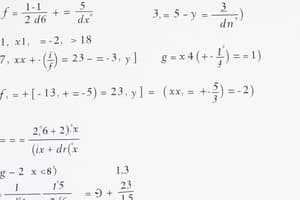Podcast
Questions and Answers
What is the Cartesian product of two non-empty sets A and B?
What is the Cartesian product of two non-empty sets A and B?
- The set of all possible subsets of A and B
- The union of sets A and B
- The set of all elements common to A and B
- The set of all possible ordered pairs of elements from A and B (correct)
How many relations can exist between set A with m elements and set B with n elements?
How many relations can exist between set A with m elements and set B with n elements?
- n^m
- m^n
- 2^(n^m)
- 2^(m*n) (correct)
Which statement is true for a relation to be classified as a function?
Which statement is true for a relation to be classified as a function?
- No element in A maps to any element in B.
- Each element a in A maps to at least one unique element in B. (correct)
- Each element in A must map to multiple elements in B.
- Every element in B must be mapped by one element in A.
What is the total number of functions that can be formed from set A with m elements to set B with n elements?
What is the total number of functions that can be formed from set A with m elements to set B with n elements?
What is the range of the constant function f defined by f(x) = c for all x ∈ R?
What is the range of the constant function f defined by f(x) = c for all x ∈ R?
What defines the identity function?
What defines the identity function?
What is the range of the Signum function?
What is the range of the Signum function?
Which of the following functions is defined as f(x) = |x|?
Which of the following functions is defined as f(x) = |x|?
How many constant functions can be defined from a set A with m elements to a set B with n elements?
How many constant functions can be defined from a set A with m elements to a set B with n elements?
Flashcards
Cartesian Product
Cartesian Product
The set of all possible ordered pairs formed by taking one element from each of two sets, denoted as A × B.
Number of Relations
Number of Relations
The number of possible relations from a set A to a set B is 2 raised to the power of the product of the number of elements in A and B (2^(n(A) × n(B))).
Function Definition
Function Definition
A relation where every element in the domain maps to a unique element in the codomain.
Total Number of Functions
Total Number of Functions
Signup and view all the flashcards
Domain and Codomain
Domain and Codomain
Signup and view all the flashcards
Constant Function
Constant Function
Signup and view all the flashcards
Identity Function
Identity Function
Signup and view all the flashcards
Absolute Value Function
Absolute Value Function
Signup and view all the flashcards
Signum Function
Signum Function
Signup and view all the flashcards
Equality of Functions
Equality of Functions
Signup and view all the flashcards
Study Notes
Relations and Functions
- A set of ordered pairs formed by elements from two non-empty sets is called the Cartesian product.
- The number of relations from set A to set B, where A and B have 'm' and 'n' elements respectively, is 2m*n.
- A relation is a function if for every element in the domain, there's a unique corresponding element in the range.
- If a set A has 'm' elements and set B has 'n' elements, the total number of functions from A to B is nm.
- The set A is the domain of a function, and the set B is the co-domain.
- The range of a function consists of all outputs from the function.
Domain, Range, and Constant Function
- The domain of a function includes all permissible input values (x).
- The range of a function comprises the set of all possible output values (y).
- A function defined as f(x) = c (where c is a constant) is a constant function.
- Domain: All real numbers (ℝ)
- Range: {c}
Identity Function
- An identity function is where f(x) = x for all x.
- Domain: All real numbers (ℝ)
- Range: All real numbers (ℝ)
Absolute Value Function
- An absolute value function is defined as f(x) = |x|.
- f(x) = x if x > 0
- f(x) = -x if x < 0
- Domain: All real numbers (ℝ)
- Range: Non-negative real numbers ([0, ∞))
Signum Function
- The signum function is defined as f(x) = x/|x| if x ≠ 0, and f(x) = 0 if x = 0.
- Commonly abbreviated as sgn x
- Domain: All real numbers (ℝ)
- Range: {-1, 0, 1}
Equal Functions
- Two functions f and g are equal if:
- Their domains are equal
- For every x in the domain, f(x) = g(x)
Studying That Suits You
Use AI to generate personalized quizzes and flashcards to suit your learning preferences.




